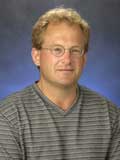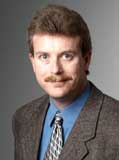 Scott Dee Scott Dee
I was born in Rochester, Minnesota, where I gained my first exposure
to veterinary medicine working on the Mayo Clinic research farm. Here
I experienced first hand the role of animal models in human disease research.
The pig was used in a number of these models, and I quickly fell in love
with this inquisitive, entertaining creature. After graduation, I received
my BA in biology from Gustavus Adolphus College in 1981 and my MS in
veterinary microbiology from the University of Minnesota in 1985. In
1987, I graduated from the University of Minnesota College of Veterinary
Medicine and spent the next 12 years in a swine-specific practice in
Morris, Minnesota, working with porcine reproductive and respiratory
syndrome (PRRS) in 33 US states and 22 countries. During my time in practice,
I became board-certified in veterinary microbiology and obtained my PhD
in veterinary medicine from the University of Minnesota. In 1999, in
an effort to further the knowledge on transmission and elimination of
the PRRS virus, I left practice and joined the swine medicine faculty
at the University of Minnesota College of Veterinary Medicine, where
I am currently an Associate Professor in the Swine Disease Eradication
Center. I also serve as Chair of the Committee on Admissions and Scholastic
Standing and am a member of the Veterinary Medicine Graduate Program
Advisory Committee. I have received the AASV Swine Practitioner of the
Year award, the AD Leman Science in Practice award, the University of
Minnesota College of Veterinary Medicine Distinguished Alumnus award,
and the AVMA Practitioner Research award. My wife Lisa and I have 2 children,
Nicholas (age 6 years) and Ellen (age 3 years). I serve on my local church
council and am active in the preveterinary program at Gustavus Adolphus
College.
Candidate’s message
During the Leman Conference, I was asked to consider running for the
office of the Vice President of the AASV. At first, I was unsure if I
was qualified, for I was not confident that I possessed the proper set
of skills to truly benefit the membership in this role. Prior to this
discussion, I had thought that the best way for me to "give back" to
our organization was by focusing all my time and effort on PRRS research.
However, the more I considered the idea, the more appealing it became.
As we all recognize, the North American swine industry is undergoing
a dramatic paradigm shift in regards to its future with PRRS. New initiatives
from the National Pork Board are calling for a cooperative effort among
scientists, practitioners, industrial partners, and producers to explore
the potential for widespread PRRS eradication. For the first time, governmental
funding agencies such as the National Research Initiative are calling
for cooperative proposals that focus on applied research in animal biosecurity,
and the PRRS virus is a targeted pathogen. Finally, practitioners around
the country are aggressively initiating their own PRRS eradication projects
at the farm level.
On the basis of this sudden change in paradigm, I believe that during
the next 2 to 3 years some very big decisions will be made that will
shape the future of PRRS in North America. Clearly, the AASV needs to
play a major role in influencing these outcomes. In the past, it has
been difficult for us to speak about PRRS with a clear, unified voice,
and this has shaken the confidence of the industry. We must rebuild this
confidence. During these impending times of uncertainty and change, the
AASV needs to present a unified front when it comes to topics concerning
PRRS and the way the swine industry should proceed in the future. I believe
that an effective way to achieve this goal, and at the same time identify
and develop new opportunities, may be to elect an AASV officer who will
represent our position on PRRS. This will require someone with unique
talents and experiences. This person must be knowledgeable in regards
to the inner workings of the PRRS world and must be capable of fulfilling
a number of roles. For example, this person must be able to work with
scientists and still keep in mind the needs of the practitioner. This
person must speak from experience with a clear voice when explaining
the importance of PRRS to potential funding agencies and legislators
and, at the same time, must lead educational efforts to transfer the
latest PRRS research data to the AASV membership. Finally, this individual
must be a recognized and respected presence in the global PRRS arena
and must always try to promote and protect the spirit of cooperation
that for the first time is developing between PRRS researchers across
the country.
As your Vice President, I want to represent our membership as we transition
from an industry that is forced to live with PRRS to one that chooses
to live without it. With my background, I feel I am qualified to serve
in this role. I have the experience as a private practitioner who has
dealt with PRRS on local, national, and global levels. I am, and will
continue to be, an active PRRS researcher and can therefore critically
evaluate whether research proposals, on-farm solutions, or strategic
plans will be capable of achieving practical outcomes. I have an excellent
relationship with many of our industrial partners and production companies.
Finally, I have dealt with a number of PRRS-related issues in the courtroom
and understand the workings of the legal profession.
If elected, my vision is to serve as the AASV PRRS liaison and promote
the position of the organization throughout the swine industry. To succeed,
I will need your input on the key PRRS issues and advice on how to deal
with them. I want to work side by side with practitioners, the National
Pork Board, industrial partners, and the NC-229 regional PRRS research
team. I want to stimulate more interaction between these groups and our
current AASV PRRS subcommittee. I also want to seek out new opportunities
for large-scale funding of basic and applied PRRS research and promote
collaboration between scientists, practitioners, and the industry. To
do this, I will need to eliminate barriers currently existing within
our industry that have impeded progress, and foster "win-win" relationships
that produce effective results. So, as you see, I will need your help
and we will need to cooperate.
I am aware that this is indeed a focused agenda; however, I believe
that a lot of important events are going to take place in the near future.
We need to proactively position our leadership in preparation for this
change. Therefore, I am asking you for the opportunity to use my talents,
experience, and resources to "give back" to the AASV through
this unique PRRS platform. I believe that the timing is perfect. Thank
you in advance for your support.
Scott Dee |
 Harry Snelson Harry Snelson
Harry graduated from the North Carolina State University College of
Veterinary Medicine in 1990. Following graduation, he entered the first
Swine Medicine Internship co-sponsored by the College of Veterinary Medicine
and Carroll’s Foods, Inc. After completion of the internship program,
he was hired as the swine veterinarian for Carroll’s Foods, where he
worked until accepting his current position as Manager, Swine Technical
Services, for Schering-Plough Animal Health in September 2000.
In January 2000, Harry was one of five swine veterinarians selected
to participate in the first Swine Emphasis Foreign Animal Disease Diagnostician
training course at the Foreign Animal Disease Diagnostic Laboratory on
Plum Island, New York. He spent the month of May 2001 in Wales, UK, working
with the USDA and UK Ministry of Agriculture on the eradication of foot-and-mouth
disease and has served as Chair of the AASV Foreign Animal Disease Committee
since 2002. Harry also serves as the Foreign Animal Disease Section Editor
for the AASV e-Letter.
He joined the AASV in 1987 and has served on the Board of Directors
as the District #2 representative since 2000. He is also a long-time
member of the US Animal Health Association and the National Institute
of Animal Agriculture (NIAA; formerly Livestock Conservation Institute)
where he has participated on a number of committees involving foreign
animal disease, pseudorabies eradication, swine health, and emerging
diseases. He currently serves as the Vice Chair for the NIAA Production
Animal Food Safety Committee.
Harry and Jan currently live in Burgaw, North Carolina. Jan has a thriving
equine practice in eastern North Carolina. They enjoy boating, snow skiing,
and playing with their three dogs.
Candidate’s message
When I entered veterinary school, my plan was to go into a mixed animal
practice. I was not raised on a swine farm and had no previous experience
with animal agriculture. During my first year, I was introduced to the
opportunities available in swine medicine by the professors in the Food
Animal Department. It has been a fascinating time to be involved in the
swine industry. I have seen firsthand the tremendous changes in the industry
and the evolution of the swine veterinary profession. When I began my
career in 1990, Carroll’s Foods was the second largest swine production
company in the United States, with approximately 45,000 sows in two states.
During the next 10 years, we grew as the industry did. When I left Carroll’s,
we had 175,000 sows and operations in five states and three foreign countries.
During the month I spent in Wales battling foot-and-mouth disease, I
came to realize the devastating effects such an outbreak would have on
US animal agriculture. The loss in animal numbers is staggering enough,
but is just the tip of the iceberg. It would have a rippling effect throughout
the economy. This has further heightened my interest in working to protect
our industry to enable us to continue to produce the safest and most
economical food in the world.
I have been fortunate to have worked for employers who have seen the
value of allowing me to be active in the industry that supports my career.
I have had incredible opportunities to work with many of the leaders
in our profession, both domestically and internationally. It has been
a pleasure to have been able to give a little something back to the profession
and to the industry that has been much of my life for the last 13 years,
by working with the AASV committees and Board of Directors.
Our profession and our industry have many challenges ahead. I would
like to have the opportunity to continue to work to bring to our membership
the tools necessary to make our careers successful, invigorating, and
prosperous by serving as the Vice President of this organization. Through
my tenure with the Board, we have attempted to manage the association
in such a way as to promote the interests of the membership. We need
to continue this leadership to address the issues our profession faces
every day – issues that include animal welfare, antibiotic use, food
safety, disease management, auditing, and a continued consolidation in
our industry. Our membership numbers are declining, and so it becomes
ever more important that we provide value to our members, aggressively
address the issues that threaten our profession, and promote the professionalism
and expertise of our membership.
I would welcome your vote for Vice President and thank you for the opportunities
you have given me.
–Harry Snelson |